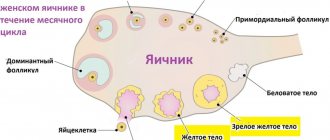Ultrasound is an important diagnostic procedure during gynecological examination. It is especially important for monitoring the development of the fetus. Thanks to ultrasound diagnostics, it became possible to visually assess the embryonic development of a child and determine whether the baby’s development corresponds to the estimated gestational age. The doctor can determine not only the level of development of the fetus, its size, but also find out what condition it is in, i.e. identify his possible suffering (for example, hypoxia). This helps obstetricians and gynecologists formulate the right pregnancy management strategy. Ultrasound, as a diagnostic method, allows you to confirm the very fact of pregnancy.
Ultrasound diagnostics can confirm or deny the fact of pregnancy with almost one hundred percent probability
When can pregnancy be confirmed using an ultrasound?
There is no point in running for an ultrasound the day after unprotected sex. The size of the egg, even a fertilized one, does not allow it to be seen with ultrasound imaging. How long does it take to see the fertilized egg and determine its size? You can see the embryo when the fertilized egg is at least 1 cm. If there is a delay in menstrual bleeding for a week, by this time the gestation process has approximately reached 6 weeks. By this period, when diagnosed with a high-precision device, the fertilized egg is already visible. It is not yet possible to determine the presence of a heartbeat in the embryo and examine its structure.
Due to the peculiarity of ultrasound diagnostics in the early period of gestation, namely the need to insert a transducer into the vagina, such an examination is carried out strictly according to indications. The grounds are suspicion of ectopic implantation of the fertilized egg, hydatidiform mole.
There may be other considerations based on which the gynecologist suggests this procedure to the woman.
When is a qualified, experienced specialist using a good device that provides high-quality visualization able to recognize the signs of pregnancy? After 3 weeks. Ultrasound diagnoses the ectopic location and implantation of the ovum after 2 weeks (transvaginally) and on the 20th day after conception (through the peritoneum). To help with ultrasound diagnostic data, a blood test is usually prescribed. HCG levels allow us to judge the implantation of the embryo. At 7-8 weeks (from about 10 days of delay), a good ultrasound diagnostician determines pregnancy with almost 100% certainty.
Stages of embryo development
In science, a human embryo is understood as a living organism, starting from the stage of emergence and up to the 10th obstetric week. Obstetric term refers to the calculation of the duration of pregnancy from the beginning of the last menstruation. If you count exactly 10 weeks from this day, you can get the duration of embryo development.
Then the existence of the fetus begins, and until birth the child is called that way. The development of the embryo is viewed day by day and calculated accurately, because it is at this moment that the unborn child is exposed to risks and the likelihood of miscarriage is high. In addition, at this time, organ systems are laid down and the nerve column is formed, which is very important.
There are several of them:
- At the moment of fertilization, the genes of the father and mother are mixed in the cell, which means that a fundamentally new and perfect genotype is formed. The division mechanism starts, and 30 hours after fertilization, the cell is divided into two parts, then into 4, and so on. The cells are so small that the size of the embryo does not increase much, and it is called a morula.
- After the morula has slowed down in its division, the process of cell migration begins, resulting in the formation of a hole in the center of the morula. The embryo is now called a blastula. There are hundreds of cells in it; It is during this period that identical twins may appear.
- At this stage, the cells of the small embryo begin to move and form three layers. Each of the cell layers will in the future be separate organ systems. At this point the organism is called a gastrula. In time, this period occurs on the 8th day after fertilization.
- The process of implantation begins - the attachment of a new organism to the wall of the uterus.
- Formation of the nervous system. The neurula stage begins, during which the foundations of the nervous system are laid. That is why it is necessary at such a moment to avoid stress, illness, as well as the use of antibiotics, alcohol and other harmful substances.
- After the formation of the nervous system, blood vessels appear, and from them - the heart of the unborn baby. This is the 20th day. The first heartbeat is heard between 22 and 28 days. It is at this time that the lungs, ears, spinal cord and mouth appear, as well as the spleen and tail. The embryo then enters the fetal stage.
Now that we have dealt with the initial stages of the formation of the human body, we can move on to answering the question of when an embryo is visible on an ultrasound.
Why doesn’t an ultrasound “show” pregnancy?
If all the signs of gestation are present, the level of gonadotropin indicates successful implantation of the embryo, and ultrasound data does not show a fertilized egg and does not confirm the fact of pregnancy in a particular patient, this does not mean that the pregnancy did not take place. The reasons that an embryo is not visible on ultrasound may be the following:
- a transabdominal sensor was used;
- low accuracy of equipment;
- incorrect calculation of gestational age, ultrasound diagnostics are carried out too early, the fertilized egg is not visualized;
- gynecological pathology (corpus luteum cyst, for example).
For the expectant mother in this situation, the main thing is not to panic. You need to repeat the hCG test (its readings should double in 2 days - this is an indicator of a normally developing pregnancy) and re-visit the ultrasound room in a week.
The use of a transvaginal sensor is much more informative for identifying a normally located embryo than a transabdominal examination
Embryo parameters
In the first days after conception, the embryo does not look like a person, rather like a rounded shell with a tail. But as it grows, its appearance changes, and if at 5–7 weeks the embryo resembled the letter “C”, then after a week on an ultrasound the doctor will see the head and arms of the embryo as a separated part of the body.
The fertilized egg normally has the shape of an oval and is dark gray in color. So that the gynecologist can monitor the baby’s development on an ultrasound, 2 indicators of this period are measured:
- SVD (diameter of the fertilized egg along the internal contour);
- KTR (coccygeal-parietal size).
What justifies the need for early ultrasound diagnostics?
If the hCG result is 1000-2000 mU per liter, ultrasound can be effective. This study will help the obstetrician-gynecologist recognize possible early pregnancy problems and its normal state. It could be:
- ectopic pregnancy;
- confirmation of the fact of embryo implantation;
- finding out the reasons for delayed menstruation in the absence of pregnancy;
- establishing the gestational age (the shorter it is, the more accurate the data);
- determination of pregnancy fertility (not always possible);
- establishing the threat of failure.
Ultrasound diagnostics in the early period is carried out only in exceptional cases, but it is still better to wait 5-8 weeks. At this time, the embryo is visible and the speed of its development can already be determined.
If an ultrasound was performed early, the size of the corpus luteum is suspected of pregnancy. If menstruation is delayed and the size of the corpus luteum is at least 16 mm, we can talk about pregnancy, although the fertilized egg is not yet visible.
Which fertilized egg produces an embryo: size and timing
If a woman's menstrual period is late, even by one day, a positive pregnancy test suggests that pregnancy has occurred. But this does not mean that there is already an embryo in the uterus. From the moment of fusion of two germ cells, only on the seventh day, and maybe later, the fertilized egg enters the uterus, where the fertilized egg is implanted into its wall.
It happens that the fertilized egg has formed and has even become embedded in the mucous wall of the uterus, but there is no embryo in it. There is such a pathological condition as anembryonia. That is, an ultrasound shows the presence of a fertilized egg and the absence of an embryo in it, regardless of what week it is. This happens as a result of exposure to infectious diseases, the influence of drugs, and genetic abnormalities at critical times, namely during the implantation period.
The opposite picture of anembryonia also occurs, when an ultrasound examination detects one fertilized egg and two embryos in it. We are talking about a multiple pregnancy, which will be visible somewhere from six weeks of gestation. Data from the medical literature provide an answer to the question: “can two embryos grow and develop simultaneously in a fertilized egg?” Yes, of course they can, but the phenomenon is quite rare.
We suggest you read: Children's baby teeth fall out early
When an embryo appears in the ovum, the size of the embryo and ovum can only be determined by competent ultrasound diagnostic specialists. You can see pregnancy on an ultrasound as early as three to four weeks, when the fertilized egg reaches approximately three millimeters. Further, with the appearance and growth of the embryo, its size increases. At five weeks it is seven millimeters, and at eight weeks it is twenty-seven or more millimeters.
Ultrasound determines not only the size, but also the growth parameters of the fetus (development of the cardiovascular system, musculoskeletal system), and excludes pathologies. It is for this purpose that the first ultrasound is prescribed at eleven weeks to ensure the physiological growth and development of the fetus. This method is also used in the second and third trimester of pregnancy, and a large number of ultrasounds are possible over the entire nine months.
As a result, no matter how happy you may be from the appearance of two lines on the test, it is necessary to diagnose pregnancy correctly and consistently.
When the outlines of the embryo in the egg are discerned, the baby’s heartbeat is listened to using an ultrasound machine, and the slightest movements are recorded, gynecologists confirm a viable pregnancy.
It is difficult to say exactly how many weeks must pass from conception to see the embryo in the form of a point and hear the baby’s heart rhythm, since each pregnancy develops individually.
In obstetrics, average periods are taken as the norm, while the method of scanning through the vagina makes it possible to discern changes earlier than the superficial one.
| Measurement/Method | Transabdominal | Transvaginally |
| Diagnosis of intrauterine pregnancy, weeks | 5–6 | 4–5 |
| Embryo imaging, weeks | 6 | 5 |
| Embryo movements, weeks | 7–8 | 5–6 |
| Cardiac activity, weeks | 6–7 | 5–6 |
The cardiac muscle of the embryo begins to contract at 3 weeks and 4 days. It is better to detect the heartbeat using a vaginal sensor. Sometimes it happens that at this stage they don’t see anything in the egg, then they recommend coming for another ultrasound in about a week, or even two. Heart rate (HR) will help determine the duration of pregnancy.
| weeks | Heart rate, beats/min. |
| 5 | 80–85 |
| 6 | 102–126 |
| 7 | 127–149 |
| 8 | 150–172 |
| 9 | 175 |
If after a week, at 6-7 obstetric weeks, nothing can be seen or heard in the egg, then doctors will make a preliminary diagnosis - anembryony. However, even in this case, gynecologists advise not to rush and undergo an additional examination a little later, in another week, especially with an irregular cycle.
What period does ultrasound show and its accuracy?
The age of the fetus is determined by obstetric and embryonic methods. The first one is counted from the 1st day of the last menstrual bleeding, the second one counts the gestational time from the day of conception (this date is considered the day of ovulation). The embryonic period is 2 weeks shorter than the obstetric period. During the ultrasound procedure, the obstetric method of reference is considered the basis. The procedure itself is not a computational mechanism for calculating gestational age. It consists in determining the degree of fetal development and correlating the data with the obstetric period. The accuracy of ultrasound (in determining the number of weeks of pregnancy) directly depends on the gestational age itself:
- up to 12 weeks – accuracy is 1-2 days;
- from 12 to 28 weeks – the error is a week in both directions;
- after 28 weeks the error increases.
After 12 weeks, the accuracy of determining the gestational age decreases significantly
Cost of ultrasound services in our Center
| 1st trimester: Ultrasound during pregnancy with early diagnosis of congenital malformation and calculation of the risk of Down syndrome (11 weeks 6 days - 13 weeks and 6 days), one fetus, using 3D/4D reconstruction | 2000 rub. |
| 2nd trimester: Ultrasound during pregnancy (18 weeks 0 days - 21 weeks and 6 days), one fetus, using 3D/4D reconstruction | 3100 rub. |
| 3rd trimester: Ultrasound during pregnancy (30 weeks 0 days - 34 weeks and 6 days), one fetus, using 3D/4D reconstruction + Dopplerometry | 3600 rub. |
View all prices
Make an appointment by phone 8 (812) 62-812-99
The timing of the ultrasound does not coincide with the obstetric one: reasons
A deviation of 14 days in both directions is not considered a pathology; obstetric practice allows this. For example, if the ultrasound timing exceeds obstetric calculations in the initial period of gestation, the reason may be an error in determining the obstetric timing due to the fact that almost immediately after fertilization there was slight bleeding, which the woman mistook for menstruation. The second reason may be the large size of the fetus.
When researching, it is necessary to take into account the baby’s heredity. Large parents may have large children, short miniature couples may have small children. Also, the fetus on ultrasound may be smaller in size than it should be according to the estimated term, if the doctor recorded the embryonic period. This is where the natural reasons end.
The fetus may develop inconsistently with hypoxia or other pathologies. To clarify the condition of the child in the womb, the doctor prescribes Doppler testing. For a woman, this procedure is no different from the studies she has already undergone, but it allows the diagnosis to be clarified.
Is ultrasound safe at the embryonic stage?
The high-frequency wave examination method is non-invasive and allows for relatively safe monitoring of the child’s development. However, despite the confirmed harmlessness to the embryo, it is recommended to conduct an ultrasound session for a short time, no more than 15 minutes. During the period of formation of organs and systems, experienced doctors try not to delay the diagnostic time and do not keep the sensor in one place for a long time.
We invite you to find out which backpack is best for children
During pregnancy, a woman undergoes at least 3 ultrasound examinations. Each screening includes an ultrasound scan and blood test. Later, observing how the pregnancy progresses, the doctor decides how much additional ultrasound sessions are required.
What to do if the size of the fetus does not correspond to the obstetric period?
Consult your doctor. He will conduct an examination, determine the height of the uterus and measure the abdominal circumference, evaluate the mother's condition and suggest either hospitalization or re-examination in a week. There is no need to refuse hospitalization and repeated examination, because not only the condition of the expectant mother, but also the life of her child depends on this. The hospital may conduct additional examinations that will either show that everything is normal or help prescribe adequate treatment.
Ultrasound diagnostics is an art. Much depends on the qualifications of the doctor. A good specialist using precision equipment is able to determine pregnancy with a vaginal sensor for a period of 3 weeks or more (using the obstetric method). But actually, at how many weeks a doctor can confirm a pregnancy depends on the individual case.
- Types of ultrasound diagnostics
- Why is the fertilized egg not visible during the examination?
- Anomalies of prenatal development
The fertilized egg is visible on ultrasound in the sixth week after conception; the size of the embryo is approximately 1 cm. In accordance with the standards of the World Health Organization, the first study should be carried out at 10-14 weeks of pregnancy. But few parents want to wait that long. Everyone wants to make sure that the pregnancy is intrauterine and the unborn baby is developing normally.
Immediately after discovering pregnancy, every woman should contact an antenatal clinic for registration. Doctors will monitor her throughout the pregnancy, monitor the development of the fertilized egg in the early stages of pregnancy, anticipating possible risks.
Ultrasound is one of the most accurate studies that allows you to determine pregnancy, monitor the development of the fetus, and diagnose embryo pathologies. Thanks to this examination, many lives of both children and their mothers have been saved.
Indications for the study
During embryo development, ultrasound is used for:
- determining what week of pregnancy the expectant mother is in;
- measuring the size and weight of the fetus, assessing their compliance with the norm;
- embryo viability assessment;
- identifying developmental pathologies;
- determining the size, maturity of the placenta, its place of attachment;
- determining the amount and properties of amniotic fluid;
- finding out the sex of the child.
The opinion that you need to visit a doctor only when an embryo is visible on an ultrasound is fundamentally wrong. Throughout pregnancy, the study is carried out three times - at 10-14 weeks, 20-24 weeks, 32-34 weeks.
After embryo transfer using IVF, the purpose of ultrasound is:
- confirmation of fixation of the fertilized egg in the uterus;
- visualization of embryo viability;
- exclusion of ectopic pregnancy;
- determination of the number of embryos;
- localization of the fetus and placenta in the uterus;
- checking the uterine cavity for neoplasms simulating pregnancy;
- clarification of gestational age by week.
Read more about ultrasound after IVF here.
Types of ultrasound diagnostics
Transvaginal and transabdominal examinations are considered particularly effective in the early weeks of pregnancy. This ultrasound allows you to examine the location of the fertilized egg in the uterine cavity. The study can also determine ectopic pregnancy.
It is not always possible to see the membranes of the fetus using ultrasound, even at 5 weeks. Even if the embryo is not visible, an experienced specialist should notice the thickening of the uterine walls characteristic of pregnancy. The procedure is repeated after 1-2 weeks as prescribed by the doctor.
Information about the prenatal development of a child can be obtained using the following types of ultrasound diagnostics:
- 3D and 4D studies;
- dopplerography;
- cardiotocography.
Diagnostics using three-dimensional images allows you to examine the baby, his face, arms, legs - that part of the body that he wants to turn around. This ultrasound is performed in later stages of pregnancy, when the child’s body is more or less (depending on the number of weeks) formed. This is a color study, most often the baby is shown in golden color.
A Doppler study allows you to evaluate the fetal circulatory system, as well as examine the uterus and placenta. Such an ultrasound can be prescribed by a doctor at any stage of pregnancy. It makes it possible to confirm or refute a defect of the cardiac system, exclude a frozen pregnancy, and check the functioning of the fetal heart. At a later stage, Doppler ultrasound may indicate a lack of oxygen.
Cardiotocography (CGT) determines the level of oxygen starvation of the fetus and records the calm heartbeat of the child under the influence of changes occurring in the uterus. If necessary, an examination is prescribed by the observing gynecologist.
Return to contents
Introduction
Ultrasound (ultrasound) is a study that is very often used to monitor the condition of the baby at any stage of pregnancy, even when only an embryo is visible on ultrasound. This is due not only to the information content, but also to the ease of diagnosis, accessibility and safety of the technique.
During pregnancy, ultrasound is used in several cases:
- When it is necessary to confirm the fact of pregnancy.
- The time has come to measure the size and weight of the baby, assess their compliance with accepted standards for each period.
- If it is necessary to assess the viability of the child.
- Identify developmental abnormalities.
- When you need to determine the size of the placenta, its maturity, and indicate the place of attachment.
- Determine the amount and properties of amniotic fluid.
- If you want to determine the sex of the baby.
According to modern rules, every pregnant woman undergoes an ultrasound examination and is observed by a gynecologist. Many people think that they need to go for an ultrasound when the embryo is visible.
However, usually the very first examination is carried out from the tenth to the fourteenth week, the second is prescribed from the twentieth to the twenty-fourth, and the third from the thirty-second to thirty-fourth week. If something happens during pregnancy, or the doctor suspects the development of any pathology, then additional examinations are prescribed.
The procedure can be carried out in two ways: with an abdominal sensor (when the abdomen is examined, onto which a special gel is applied) or vaginal (through the vagina) . The second method is used if the fetus is not visible on a standard examination.
Why is the fertilized egg not visible during the examination?
Expectant mothers often ask the same question: when is a fertilized egg visible on an ultrasound? There are often cases when at 8 or even 12 weeks the fetal heartbeat cannot be heard and is not visible. Don't despair! Ultrasound diagnostics do not always provide 100% information. The result can be influenced by many factors, both technical and human. Doctors recommended conducting several studies to confirm the information received. This is not only an ultrasound, but also laboratory tests and gynecological examinations.
As sad as it is to realize, inaccuracies in ultrasound diagnostics have interrupted the lives of more than one baby, and yet these are isolated cases that do not occur so often. Basically, ultrasound gives a reliable result, but if there is a risk of a frozen or ectopic pregnancy, it is necessary to undergo a more in-depth examination.
If the ultrasound does not detect an embryo in the fertilized egg, it is necessary to conduct a blood test for hCG (human chorionic gonadotropin). With positive dynamics, the level of this hormone increases in proportion to the weeks of gestation. The possibility of incorrect calculation of the period cannot be ruled out. Perhaps he is too small to see the fetus on the instruments. Doctors count the gestational age in obstetric weeks, that is, from the first day of menstruation inclusive, so errors in calculations are common. It is worth going to another medical institution and undergoing ultrasound and tests again. Don't rush into agreeing to a cleanse until you've exhausted all your options.
The week at which the embryo is visible on ultrasound, and not just the fertilized egg surrounding it, largely depends on the individual characteristics of the body and the location of the egg in the uterus. Modern equipment plays an important role. Usually the embryo is shown 6-7 weeks after conception.
All sorts of myths about ultrasound:
- Ultrasound negatively affects the intrauterine development of the fetus. There is no evidence to confirm or refute this fact. Scientists and doctors agree that everything should be in moderation. In a normal pregnancy, 3 routine ultrasound examinations are sufficient. Only in case of pathologies or threat of miscarriage can the number of studies be increased. Ultrasound is often not recommended in the early stages of pregnancy, but closer to childbirth you can undergo a 3D examination and get a picture as a keepsake. The fetus has already formed in recent weeks, and ultrasonic waves will not harm it.
- Under the influence of ultrasonic waves, DNA changes. During ultrasound, waves penetrate the object and are repelled from it, which allows the formation of an image. The whole process creates only a mechanical vibration of the tissues inside the mother's womb. Studies on pregnant mice did not reveal any genetic changes caused by ultrasound.
- Unnatural nature of ultrasound. This is a matter of subjective perception. Diagnostics is a voluntary procedure; the desire to undergo it depends only on the parents of the unborn baby.
- Ultrasound is an experiment. There is a deal of truth in it. The study of the prenatal life of the fetus provides a lot of material for scientific work. The knowledge and experience gained allows us to save the lives of mothers and children around the world.
In any case, the consent of the mother is required for ultrasound diagnostics. The main thing is to ensure that the doctor uses modern equipment with low radiation levels.
What to do when an embryo is not visible on an ultrasound at 9 weeks? Repeat it after a week, or preferably after 3. The examination will show what size the fertilized egg is when it is 1 cm or more. Most often, the fetus reaches this size by 6 weeks of gestation. But everything is individual. It happens that an ultrasound can clearly show that a woman is pregnant only at 8-12 weeks.
Many expectant mothers who dream of a son or daughter are concerned with the question: from what week will an ultrasound definitely confirm that she is pregnant? Experts say that from the age of 7 you can take a referral from your gynecologist and undergo diagnostics. If the examination does not show anything, and there are no menstruation, do not be upset, it happens. Sign up again in a month.
How to calculate gestational age?
The first ultrasound is prescribed when a woman comes to the antenatal clinic to register.
Usually this is a period of 10-12 weeks, if there is a positive hCG test. Then it is already possible to detect the fertilized egg along with the embryo in the uterus and identify developmental pathologies. An ultrasound can be done earlier; it will detect the embryo 14-20 days after the missed period. The second scheduled examination is done at 20-22 weeks. Here you can identify fetal malformations. The last examination is carried out 14-21 days before birth to determine the position of the fetus and the woman’s readiness for childbirth.
You can often see the question “what month are you in?” leaves the pregnant girl confused. The thing is that doctors, and after them pregnant women, count the duration of pregnancy in weeks.
Many pregnant women who go to the doctor for the first time are surprised by the deadlines. After all, according to the estimates of expectant mothers, pregnancy occurred one to two weeks later. The fact is that there are two methods for calculating the gestational age - embryonic and obstetric.
The embryonic period begins to count from conception, and the expected date of birth is set after 38 weeks. The obstetric pregnancy period is considered the oldest. It is determined by the menstrual cycle. For a long time, midwives noticed that a child is born 280 days (or nine months and a week) from the start of the last menstruation.
The obstetric period includes the entire cycle of development of a new life from the maturation of the egg to childbirth. According to the obstetric period, pregnancy lasts 40 weeks. It is about two weeks longer than the embryonic one. In the literature, as a rule, it is the obstetric term that is used.
Let us remind you that as soon as a woman finds out about her pregnancy or such a possibility arises, it is necessary to contact an antenatal clinic and register. This is necessary for a healthy, normal pregnancy. Why is it important to do an ultrasound:
- If the fact of fertilization is not confirmed, then the study will help determine the cause of disruptions in the cycle, because this may indicate a disease.
- You can understand whether implantation went well and whether there are any anomalies in the development of the embryo.
- Elimination of possible ectopic pregnancy and other negative processes that may put the child at risk.
- Ultrasound shows in advance increased tone of the uterus, the possibility of miscarriage.
- It is possible to exclude a frozen pregnancy, when the embryo stops in its development and dies, continuing to be in the mother’s body.
And, of course, it’s worth understanding when an embryo is visible on an ultrasound, because this is such an exciting question. Please note that the arguments about the harmfulness of the study are completely false and are myths. Ultrasound does not have any negative effect on either the mother or the embryo.
The transvaginal version of the study is carried out by inserting a special device into the vagina, at the end of which there are sensors, and you can view the entire internal cavity of the uterus and ovaries in great detail. What time is an embryo visible on a transvaginal ultrasound? Due to the fact that this version of the study is the most complete, the embryo can be seen already on the 21st day after conception, that is, after 3 weeks.
To prepare for such a study, it is necessary to abstain from sexual activity 2 days before the ultrasound and not to eat foods that cause gas formation. You should also empty your bladder and bowels to increase the visibility of the device. There is a contraindication in the form of aching pain, cramps in the abdominal area in a woman, red or brown discharge.
Oddly enough, the level of hCG is reflected in the results of the study. To begin with, let us recall that hCG is an indicator that increases in a woman’s body with the onset of pregnancy. It is he who influences the test to determine pregnancy, as a result of which a second strip appears. This is a type of hormone that appears on the 6th day after conception.
The first test when registering at the antenatal clinic is a blood test for hCG levels. It grows actively in the first days of pregnancy. At what hCG level is the embryo visible on ultrasound? If the result of blood tests reaches 1000 - 2000 mU per liter, the study will show an embryo.
So, using the hCG level, you can determine the presence of pregnancy and act further depending on the results and individual indicators of the pregnant woman.
How do specialists see an embryo?
Have you taken a test and found out that you are expecting a baby? Unfortunately, tests are sometimes wrong, but an ultrasound examination, starting from 9-12 weeks, will definitely show that you will soon become a mother. A referral for an ultrasound will be given by your gynecologist from the clinic. You can also contact private honey. cent, you will be given a referral for examination.
If you want to know for sure whether you are pregnant or not, ask if they will examine you with a good ultrasound machine in the 1st trimester? It is important that the equipment has high resolution and other additional functions. From 4 to 5 weeks the fetus is so tiny that it is only 1 to 2 mm.
At which obstetric week do doctors begin counting pregnancy? C1 is from the 1st day of a woman’s period. Therefore, there will be a difference of 2 weeks between the actual week of conception and the obstetric one. This is important to know in order to calculate obstetric 9 months. carrying a baby. Yes, and routine ultrasounds are performed, measuring the timing in obstetric weeks.
At what value is the embryo visible?
The chorion is a special type of embryonic cell from which the placenta is formed.
As soon as the embryo reaches the wall of the uterus and attaches to it (and this happens 5-7 days after fertilization), the placenta begins to intensively produce hCG. The pregnancy hormone begins to accumulate in the blood and urine of the woman in whose uterus the embryo is located.
From the moment of conception until 10 obstetric weeks, the embryo is called an embryo in medicine, and only after this period it becomes a fetus. By the time of the delay, the embryo can reach a period of 10 - 14 days, i.e. about 2 weeks.
An embryo at this stage is not yet visible on the screen of an ultrasound machine, but its reality is evidenced by the level of hCG in the blood of the expectant mother, which is approximately in the following range: from 30 to 300 mIU/ml.
Attention! If the hormone in the blood is determined to be between 5 and 25 mIU/l, then conception remains in question. If you donate blood again after 2 days, the hormone content should at least double, then you can talk about pregnancy.
A pregnancy test with a delay of several days may show a positive result in 2 stripes: the tests react specifically to hCG contained in the urine.
A one-time test does not say anything specifically for the following reasons:
- the body of each expectant mother reacts to pregnancy in its own way, as evidenced by the huge variation in standard indicators;
- different laboratories may use different units for measuring hormone content;
- there is, although minimal, the possibility of error in the results of the analysis;
- the tests are correct, but there is no embryo in the woman’s body, but there are other problems.
On ultrasound, the embryo is visible after 4 weeks of pregnancy; normal hCG during this period can be 1500-5000 mIU/l.
It can be examined and analyzed only in dynamics, and this should only be done by a doctor, and in conjunction with the results of other tests.
Embryo examination method
If the baby in your womb is not yet 9 weeks old, then experts recommend doing the examination using several methods:
- Using a transabdominal sensor, moving along the anterior wall of the peritoneum;
- Using a transducer. The examination is carried out through the vagina. This is a transvaginal method. The transvaginal method is considered the best way to carry a baby for a short period of time. The wave frequency used is high and on the screen the doctor sees the condition of the woman’s uterus and fetus.
How to see an embryo?
If the test shows the presence of pregnancy, then an examination with an ultrasound scanner will help confirm this. Ultrasound diagnostics are carried out in a antenatal clinic or in a private medical center.
For examination in the 1st trimester, it is important that the ultrasound machine has high resolution and wide functionality, and the doctor’s qualifications also play an important role. At 4–5 weeks, the formed fetal sac is very small and poorly visible, its size is only 1–2 mm.
To understand medical language, it is important to know that gynecologists measure the period of gestation in obstetric weeks, from the first day of the last menstruation. Therefore, the difference between the obstetric and actual terms of conception of the baby is 2 weeks.
Is ultrasound safe for the fetus?
Thanks to this method of examination, the doctor can determine at an early stage of development whether the embryo is visible, does it have abnormalities? The doctor will try to carry out the procedure quickly. The examination itself lasts on average 15 minutes.
Now is the early stage of formation of internal organs in the fetus. An experienced doctor will move the sensor faster than usual over the woman's abdomen or uterus. The ultrasound specialist will try not to hold the device for a long time over any internal organ of the baby.
During the entire pregnancy, a woman will be prescribed at least 3 scheduled ultrasounds, and some will have repeat ones. According to statistics, on average, this is 9 times during the period of gestation. The specialist does screenings from the monitor screen. In addition, the woman donates blood for tests.
"Advice. Don’t worry, the doctor will check whether your baby is normal or not? He decides on additional ultrasound examinations.”
What is the essence of ultrasound
Ultrasound is a relatively new diagnostic method with high efficiency. Diagnostics is carried out using ultrasonic waves. The examination is completely safe and does not cause any discomfort to the woman.
This is useful: about the impact of ultrasound on humans.
The method is based on the passage of ultrasonic waves through internal organs and tissues of different densities.
The examination helps to see the boundaries of structures. This makes it possible to find even minor deviations.
Ultrasound is an absolutely safe method of examination for both mother and baby
Ultrasound waves are reflected from tissues and organs and form an image that is transmitted to the monitor. The graphic image can be transferred to special photographic paper. Ultrasound is the safest, most accessible and simplest diagnostic method.
Ultrasound may be ordered repeatedly over a short period of time if necessary. Even when diagnostics are performed several times a day, the procedure does not have a negative impact on the functionality of the organs.
During an ultrasound examination, there is no radiation exposure to the patient's body. Diagnostics is included in the list of mandatory annual examinations as a preventive measure. The examination does not require multi-stage preparation.
Modern ultrasound machines have frequencies of 2–29 MHz. Sensors can be mechanical or electronic.
Ultrasound allows you to diagnose the slightest deviations in the functioning of the body
When will the ultrasound clearly show the embryo?
If the egg contains a viable embryo, the doctor confirms that the woman is pregnant and the condition of the fetus is stable. For each woman, even 1st, 2nd and subsequent pregnancies proceed in their own rhythm. In one, the fetus develops faster, in the other slower. Future mothers are wondering, how many weeks does it take for an embryo to become visible on an ultrasound from a dot and then a pea? Scans done through the vagina can diagnose pregnancy earlier than those done through the peritoneum. Average indicators are taken as the norm. It is believed that the fetus should be audible and visualized on the screen already at 6 or 7 obstetric weeks. If the specialist does not notice anything, he will make a diagnosis of anembryonia. Gynecologists advise the woman not to be upset, but to come for an examination in another 7 days. If your cycle before pregnancy was irregular, then perhaps the embryo was behind in development and therefore the specialist did not notice it. See what the baby looks like on day 21 of gestation:
Survey
Thanks to ultrasound, medical workers can quite accurately record the moment when the embryo began to have a heartbeat.
In most cases, this occurs at 3-4 weeks of gestation. At the same time, the active formation of all internal organs and systems begins. Already at about the fifth week of gestation, you can hear the first heartbeats.
For the proper development of pregnancy, it is necessary that the blood contains a normal amount of hCG. Both its decrease and increase can lead to serious consequences.
Human chorionic gonadotropin is produced by the chorion, which is subsequently converted into the placenta. The production of this hormone begins approximately 5-6 days after fertilization of the egg. From this moment, until the tenth week, it gradually increases.
After reaching the maximum value, hCG begins to decrease, and as a result, until the end of pregnancy, its levels remain at approximately the level of 6-7 weeks of pregnancy.
HCG is the most important indicator of pregnancy. It can be used to judge how well the process of gestation is proceeding. The type of hCG at which a heartbeat is heard will largely depend on the diagnostic method.
To assess the heartbeat, doctors usually use:
- auscultation (a procedure during which the fetal heartbeat is heard using an obstetric stethoscope);
- echocardiogram;
- cardiotogram;
- Ultrasound.
The last of them is the most popular, since it is the one that can show reliable results in the early stages of pregnancy.
Ultrasound diagnostics in pregnant women can be performed using two methods:
- Transvaginal. With it, the indicator is inserted into the vagina. Thus, a woman is examined starting from 5-6 weeks of gestation, that is, from the moment when there is a perceptible heartbeat. Transvaginal ultrasound is prescribed to pregnant patients extremely rarely, only in cases where the doctor suspects problems in the course of pregnancy.
- Transabdominal. In this case, the study is performed using an indicator that is applied to the woman’s stomach. This diagnostic method makes it possible to evaluate the heartbeat starting from the seventh week of gestation.
Thanks to ultrasound, it is possible to visualize the fertilized egg in the fifth week of pregnancy. At this stage, pregnant women are often interested in: “At what hCG is the fetal heartbeat heard on ultrasound?”
At the initial stage, the amount of chorionic hormone varies from 1000 to 1500 IU/l. If the amount of hCG is less, then difficulties with visualizing the ovum may appear even with transvaginal ultrasound.
As for transabdominal ultrasound, it can be used to establish the presence of a fetal egg only if the hCG concentration is 3000 - 5000 IU/l.
If we talk about at what hCG the embryo and heartbeat are visible, then it will be 7200 IU/l or more (6th week of gestation). This is provided that the diagnosis is performed using the transvaginal method.
It is important to know when an embryo is clearly visible on an ultrasound? What will they look at on an ultrasound?
If you are now 9 or 10 weeks pregnant and feel great, there is no threat of miscarriage, then an ultrasound is not necessary. It will be assigned only at your request. At this time it is impossible to say exactly the sex of the fetus. You can only determine whether the placenta is well attached to the wall of the uterus and that you are definitely pregnant. Additional examination is relevant if you have undergone IVF.
What is the point of ultrasound at this stage of embryo development:
1) Determine precisely that the fertilized egg is tightly attached to the uterus; 2) Find out how viable the fetus is; 3) Confirm that the pregnancy is normal and not ectopic; 4) Find out 1 baby or several in the uterus; 5) Determine where exactly the placenta is attached in the uterus; 6) Find out whether the fertilized egg is of the correct shape and has grown sufficiently;
Find out whether this is a real pregnancy or a tumor in the uterus?
Find out at what stage of gestation the expectant mother is. About the embryo
After conception, the embryo looks like a round shell with a tail. It grows in the womb and changes. From 5 to 7 weeks it is already like the letter “C”. Another 7 days will pass and the ultrasound specialist will determine that the embryo has a head and arms.
A normal fertilized egg looks like an oval and is dark gray. During this period, the gynecologist will be interested in 2 main indicators of the embryo: SVD or what is the diameter of the fertilized egg if measured along the contour passing inside; KTR or the size from the coccyx to the crown.
At what week of pregnancy is the embryo visible on ultrasound?
The fertilized egg can be seen starting from 3 weeks. It is a dark-colored, round formation, surrounded by a thin shell, up to 5 mm in diameter. The embryo itself cannot be seen using ultrasound during this period, it is too small. It becomes visible on the screen at the beginning of 2 months. This is an oblong-shaped object that is attached to the fertilized egg using the umbilical cord.
The gynecologist decides at what week to perform an ultrasound for the first time. It is usually carried out at 10-14 weeks. During this period, you can accurately determine the presence of pregnancy, without confusing it with a hydatidiform mole. The study also determines the duration and type of pregnancy (uterine or not).
The first examination is necessary to resolve important issues.
- The embryo is already large enough to determine the thickness of its collar zone using ultrasound. This will allow a diagnosis of Down syndrome to be made as early as possible. When the space from the skin to the soft tissues of the spine increases, special tests are prescribed for the condition of amniotic fluid, placental cells and blood from the umbilical cord.
- The development period of the embryo is determined using CTE, coccygeal-parietal size.
- The baby's heartbeat is heard. It should be rhythmic, precise and clear. This is the most important indicator of vitality. Arrhythmia may indicate a lack of oxygen (hypoxia) and congenital heart disease.
- The heart rate is determined. If it is not normal, treatment is prescribed to improve blood flow between the uterus and placenta and metabolism in the body's cells.
The second examination is carried out at 20-24 weeks. At this time, the following indicators are important:
- Head and abdominal circumference, fronto-occipital size, limb length. These data show the growth, degree of development of the fetus, and its compliance with the norm.
- Maturity, structure, location and thickness of the placenta.
- Condition of amniotic fluid, umbilical cord, cervix.
The third examination is carried out at a late stage of pregnancy to determine the position of the child, its size, weight, and to study the condition of the placenta and amniotic fluid. The final ultrasound is prescribed shortly before birth, it is not mandatory. It is used to determine the position of the fetus, its weight at birth and the entanglement of the umbilical cord.










